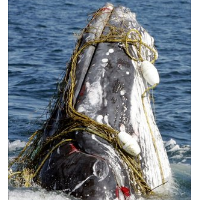Record Number of Whales Snared in Fishing Gear off West Coast
 Entrangled whale (photo: Associated Press)
Entrangled whale (photo: Associated Press)
Whales are becoming entangled in crab fishing gear, and dying, at a fearfully accelerating rate in waters off California, Oregon and Washington, according to the National Oceanic and Atmospheric Administration (NOAA).
The number of known entanglements doubled to 30 between 2013 and 2014. Seven were killed, seven were freed and the outcome of the others is uncertain. Most of the whales were endangered humpbacks, which is odd because there weren’t any of them involved the year before.
The count is already up to 25 this year, but Dungeness crab season ends June 30. The actual number of entanglements is unknown because reports are based on (pdf) what NOAA calls “opportunistic sightings.” California averaged eight entanglements a year between 2000 and 2012.
In response, the Center for Biological Diversity, Earthjustice and Oceana sent a letter (pdf) to the California Department of Fish and Wildlife asking for urgent action to do more about the gear used in the Dungeness crab, spot prawn and spiny lobster fisheries.
“There are simple, common-sense solutions that will protect the whales, and we’re calling on the state to manage this fishery to protect whales,” attorney Catherine Kilduff said in a release by the Center. “We want to see meaningful changes to address this growing problem before the next crab season begins.”
The entanglements happen when whales run into buoy lines extending from the traps below to the ocean’s surface. The gear can cut into their flesh and immobilize them, but escape does not guarantee a healthy exit. The letter says:
“Unless the whale “self-releases” or is disentangled by human volunteers, the line can remain indefinitely, impairing the animal’s ability to swim, feed, get to the surface for breath, and ultimately survive. Wounds caused by the entangled line often become infected. Sometimes these wounds lead to fins or flukes becoming necrotic and slowly being amputated by the line. In cases where the line is still attached to the traps, the animal may have to drag hundreds of pounds of gear around as it tries to swim, breathe, eat, and migrate. One study estimates that it takes an average of six months for entangled large whales to die.”
Around 800 boats fish using more than 200,000 crab pots and traps off California’s coast. Their entanglements with whales are not unknown, and the environmental groups acknowledge that significant changes have been made over the years with the cooperation of fishermen.
They made half a dozen specific suggestions about safety improvements that could be made quickly in deploying gear and outlined a framework for more long-term solutions. Those could include closer tracking of where crab fishing takes place. Currently, crab fishermen do not have to keep log books on their efforts.
The environmentalists also suggested that fishermen clean up their mess better. The California Lost Fishing Gear Recovery Project has removed “more than 60 tons of lost commercial and recreational fishing gear and debris” since 2006.
All of these efforts are complicated by shifting migration patterns that could very well be affected by climate change. Whales that normally pass through the Monterey Bay on their way to Mexico inexplicably hung around this past year. That combined with an abundant crab harvest to almost guarantee more entanglements.
–Ken Broder
To Learn More:
Number of Whales Trapped in Fishing Gear Spikes (by Jason Hoppin, Monterey County Herald)
New Data Shows West Coast Whale Entanglements Now at Record High Levels (Center for Biological Diversity)
A Record Number of West Coast Whales Were Entangled in Crab Fishing Gear (by Louis Sahagun, Los Angeles Times)
Whale Entanglements off California Fact Sheet (National Oceanic and Atmospheric Administration) (pdf)
Letter to the California Department of Fish and Wildlife (Center for Biological Diversity, Earthjustice and Oceana) (pdf)
- Top Stories
- Controversies
- Where is the Money Going?
- California and the Nation
- Appointments and Resignations
- Unusual News
- Latest News
- California Forbids U.S. Immigration Agents from Pretending to be Police
- California Lawmakers Urged to Strip “Self-Dealing” Tax Board of Its Duties
- Big Oil’s Grip on California
- Santa Cruz Police See Homeland Security Betrayal in Use of Gang Roundup as Cover for Immigration Raid
- Oil Companies Face Deadline to Stop Polluting California Groundwater





